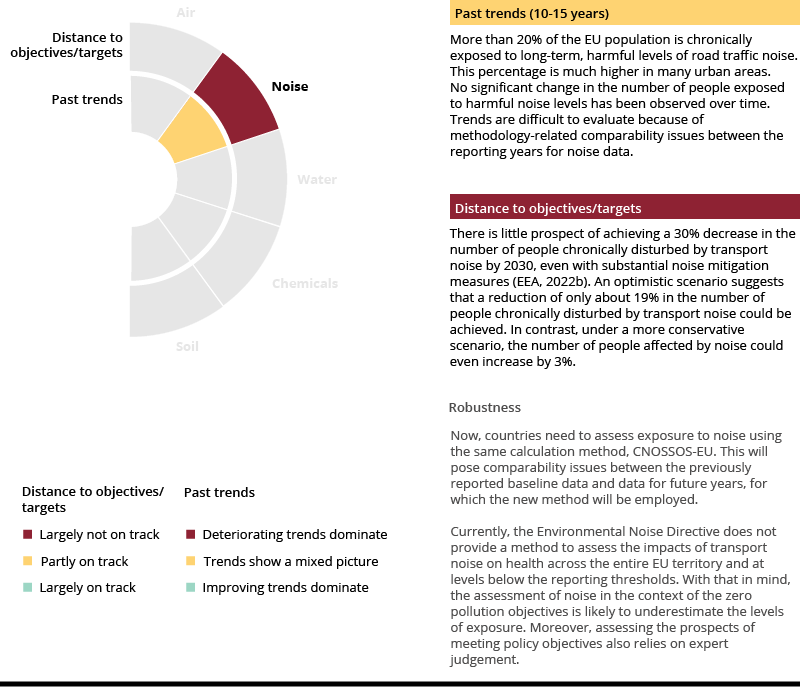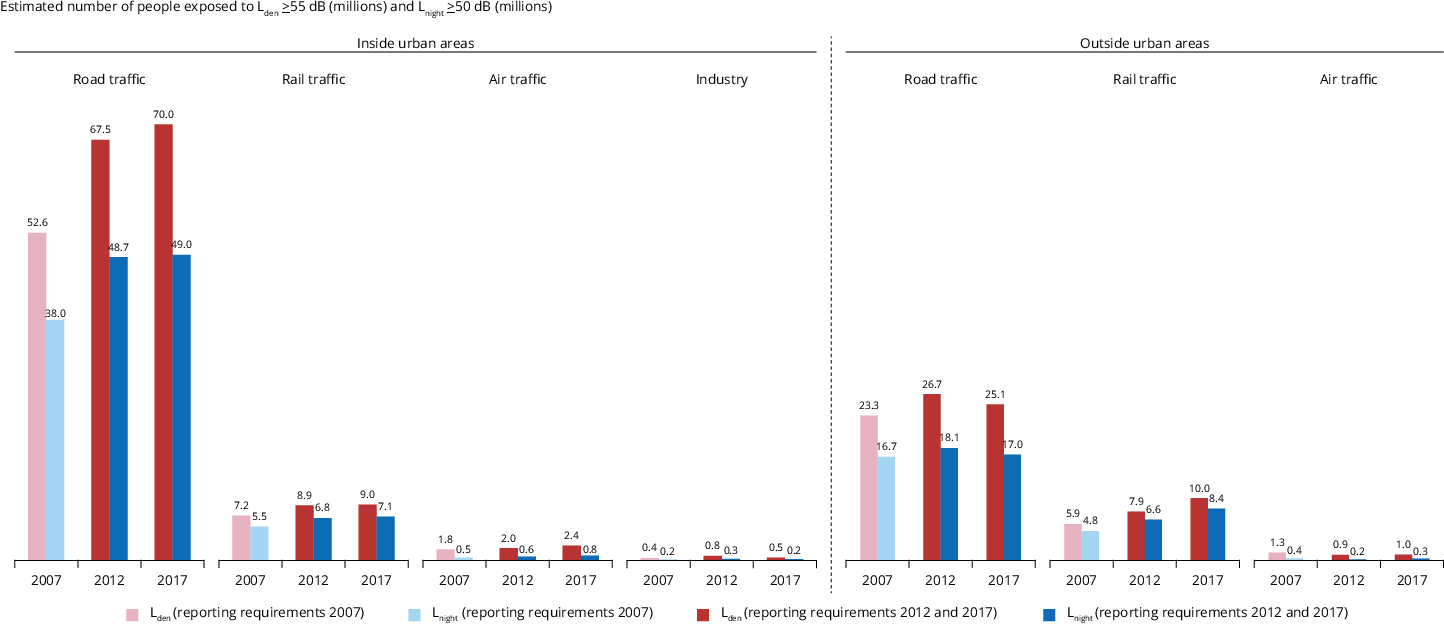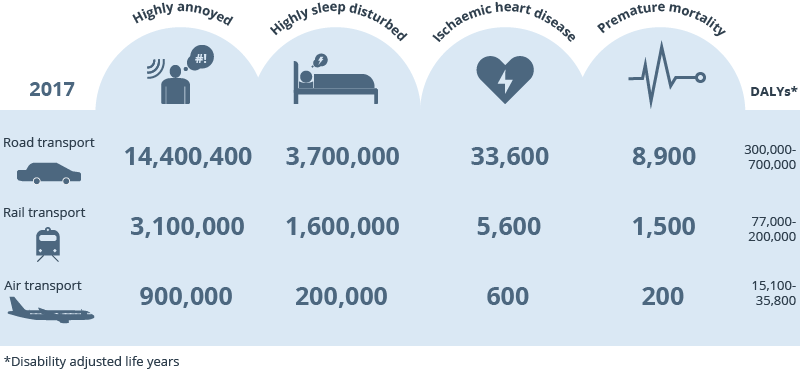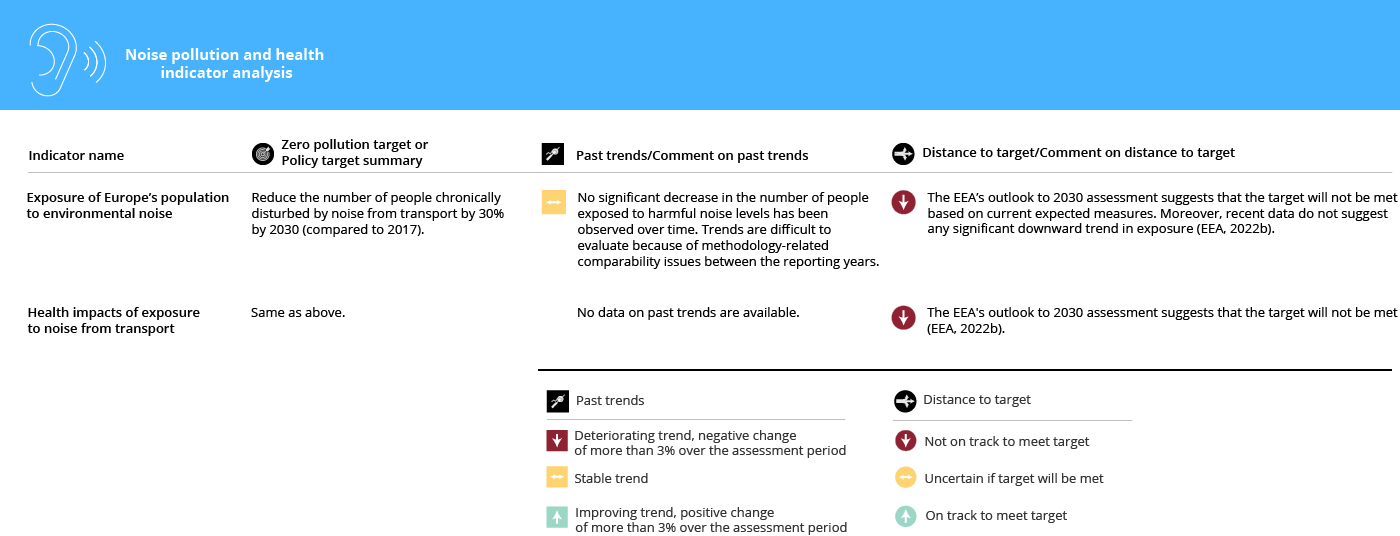Key messages
- No significant decrease in the number of people exposed to harmful noise levels has been observed between the two most recent years for which country data are reported — 2012 and 2017.
- More than one in every five EU citizens is exposed to chronic harmful levels of road traffic noise. This percentage is much higher in many urban areas.
- The number of people ‘highly annoyed’ and ‘highly sleep disturbed’ must be reduced by 5.4 million and 1.5 million, respectively, in order to meet the 2030 zero pollution targets for noise pollution. Based on levels and measures currently in place, the prospect of meeting these targets is low.
- Health impacts for Europe’s population still occur at noise levels below the thresholds set in the Environmental Noise Directive.

Guidance for interpreting the summary
The infographic above summarises the overall findings on noise pollution. Two dimensions are considered:
- whether the recent trend in pollution is positive, negative or uncertain
- the current 'distance to target', based on an assessment of the current trends or status and whether or not the EU is on track to achieve the defined zero pollution targets for 2030 and/or other relevant policy targets.
The assessment is based on a combination of (1) available indicators and data, and (2) expert judgement. Further details are included in each of the sub-sections on noise pollution below.
Introduction
Long-term exposure to environmental noise significantly affects physical and mental health. The levels of noise generated by transport sources are generally too low to cause biological damage to the ear; however, it is well established that long-term exposure to noise above certain levels can lead to non-auditory health effects such as annoyance, sleep disturbance, negative effects on the cardiovascular and metabolic systems, and cognitive impairment in children (WHO Europe, 2018).
Exposure to environmental noise is a widespread problem in Europe: at least one in five people are exposed to noise levels considered harmful to health (EEA, 2020). Reducing the negative impacts of exposure to environmental noise is a key objective under the zero pollution action plan, which aims to reduce the number of people chronically disturbed by noise from transport by 30% by 2030 (compared with 2017).
Managing human exposure to noise
Figure 10 shows the number of people exposed to noise levels that can harm health. The major source of noise pollution in both urban and non-urban areas is road traffic. Based on data reported under the Environmental Noise Directive (END), it is estimated that in 2017 (the baseline year for the zero pollution action plan target) more than 95 million people in the EU were exposed to harmful levels of road traffic noise, that is, above 55dB during the day-evening-night period (Lden). Moreover, more than 65 million people were exposed to noise levels above 50dB during the night (Lnight). Noise from railways and aircraft has a much lower impact in terms of the overall population, but both are significant sources of local noise pollution. In addition to this, the END does not comprehensively cover all urban areas, roads, railways and airports across Europe; hence, these figures are likely to be underestimated.

Source: EEA (2021).
Click here to view the figure enlarged
Click here for different chart formats and data
Comparisons of 2012 and 2017 data suggest that the number of people exposed to harmful noise levels has not decreased significantly over time. However, robust trends are difficult to establish because of methodology-related comparability issues between the reporting years (2007, 2012 and 2017) and must be interpreted with caution.
Health impacts of exposure to noise from transport
Annoyance and sleep disturbance are the most prevalent effects of exposure to noise from transport sources. Based on data reported under the END in 2017, it is estimated that, in the EU, at least 18 million people are highly annoyed and 5 million people are highly sleep disturbed because of long-term exposure to noise from transport. In addition, it is estimated that long-term exposure to noise causes 41,000 new cases of heart disease and 11,000 premature deaths every year in Europe.
These significant health impacts are likely to be underestimated, with evidence from the World Health Organization (WHO) demonstrating effects at levels below the END reporting thresholds (WHO Europe, 2018). People in urban areas are the most affected, particularly by traffic noise. In addition to the main health effects described above, noise may have wider impacts on people’s health and well-being through ways that are currently less well documented, as illustrated in the zero pollution ‘Signal’ on the emerging evidence on the adverse health effects of noise.
Based on baseline data from 2017, to achieve the zero pollution objective of reducing the number of people chronically disturbed by transport noise by 30% by 2030, the number of people highly sleep disturbed by noise in the EU must be reduced by 1.5 million, and the number of people highly annoyed must be reduced by 5.4 million (EEA, 2022a). Recent outlooks suggest that reaching these targets without further regulatory or legislative changes is unlikely, mainly because of the difficulty in reducing the large number of people exposed to noise from road traffic (EEA, 2022b).
The zero pollution monitoring framework proposes monitoring the impacts on human health of transport noise using disability-adjusted life years (DALYs). One DALY corresponds to 1 year of healthy life lost as a result of morbidity, mortality or both. The most important contributors to the total burden of disease of environmental noise are annoyance and sleep disturbance because of the large number of people affected, as shown in Figure 11.

Source: EEA (2022c).
Most people affected by traffic noise are also exposed to unhealthy air pollution levels, especially in urban areas. This combined exposure exacerbates the level of risk that they are exposed to, as discussed in the zero pollution ‘Signal’ on the combined impacts of road traffic noise and air pollution.
Note: Links to indicators: Exposure of Europe’s population to environmental noise, Health impacts of exposure to noise from transport.
Overview of indicator analysis methodology
This indicator analysis is in line with the approach taken by the EEA for its seventh environment action programme monitoring.
Past trends are based on assessment of the trend over the last 10 years (or since the relevant zero pollution baseline year where appropriate) with green, yellow or red being applied based on the criteria as outlined in the figure legend. Expert judgement is also applied, for example in cases where indicators are more qualitative and/or uncertain.
The distance to target is based on an assessment of the recent trend, current status and expert judgement.
Further detailed analysis of the future outlook for meeting certain zero pollution targets is included in the zero pollution outlook 2022, completed by the European Commission Joint Research Centre (JRC, 2022).
References
EEA, 2020, Environmental noise in Europe — 2020, EEA Report No 22/2019, European Environment Agency (https://www.eea.europa.eu/publications/environmental-noise-in-europe) accessed 6 October 2022.
EEA, 2021, ‘Exposure of Europe’s population to environmental noise’, European Environment Agency (https://www.eea.europa.eu/ims/exposure-of-europe2019s-population-to) accessed 7 October 2022.
EEA, 2022a, ‘Health impacts of exposure to noise from transport’, European Environment Agency (https://www.eea.europa.eu/ims/health-impacts-of-exposure-to-1) accessed 7 October 2022.
EEA, 2022b, ‘Outlook to 2030 — can the number of people affected by transport noise be cut by 30%?’, European Environment Agency (https://www.eea.europa.eu/publications/outlook-to-2030/outlook-to-2030-can-the) accessed 7 October 2022.
EEA, 2022c, ‘Additional information on health impacts from transport noise at EU level in 2017’, European Environment Agency (https://www.eea.europa.eu/data-and-maps/figures/additional-information-on-health-impacts) accessed 7 October 2022.
JRC, 2022, Zero pollution outlook 2022, JRC129655, Publications Office of the European Union, Luxembourg, Joint Research Centre (https://joint-research-centre.ec.europa.eu/zero-pollution-outlook-2022_en) accessed 1 December 2022.
WHO Europe, 2018, Environmental noise guidelines for the European region, World Health Organization Regional Office for Europe, Copenhagen (https://www.who.int/europe/publications/i/item/9789289053563 ) accessed 6 October 2022.
Cover image source: © Evangelija Ivanoska, Well with Nature /EEA




Document Actions
Share with others